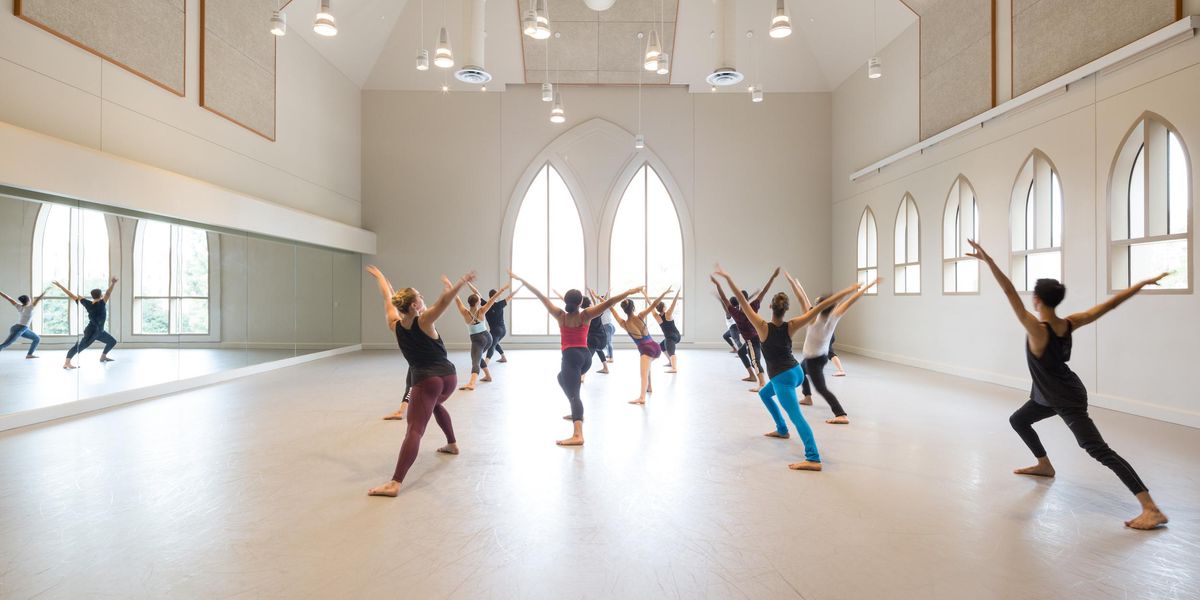Improv Night at Hubbard Street
Dancers Alice Klock and Kevin Shannon. All photography by Quinn Wharton.
Hubbard Street Dance Chicago boasts a serious, technical rep heavy on enigmatic choreographers like William Forsythe and Jirí Kylián. But this season, the dancers have taken on a whole new challenge: sketch comedy.
Chicago-based comedy giant The Second City is collaborating with Hubbard Street on an evening-length work, to premiere this month at the Harris Theater. It’s an exciting but unlikely marriage. While Hubbard Street has devoted 37 years to innovative contemporary dance, Second City has spent 55 staging wildly popular sketch-comedy shows and launching the careers of actors like Alan Arkin and Tina Fey.
The companies’ common ground is familiarity with improvisation and collaboration—and a willingness to take risks. “Hubbard Street and Second City have gone into this with open eyes,” says Glenn Edgerton, Hubbard Street artistic director. “We know it’s unknown—that’s part of the beauty of the whole project.”
Left: Second City’s Tawny Newsome with Hubbard Street dancers.
The show follows three storylines that are cut up and interwoven. Second City writer-performer Tim Mason collaborated with choreographer Robyn Mineko Williams (a former Hubbard Street dancer) on a storyline about the relationship between a dancer and a nondancer. Writer Kate James and choreographer Jonathan Fredrickson teamed up on a second storyline, and choreographers Alejandro Cerrudo and Terence Marling on the third, expected to be more purely dance, though still with a narrative element. Hubbard Street rehearsal director Lucas Crandall and writer T.J. Jagodowski created the brief vignettes that Second City calls “interstitials.”
All of Hubbard Street’s main company and Hubbard Street 2 are performing, as well as five or six Second City actors. At least that’s the plan—the main idea seems to be that nearly everything is up for grabs. “We aimed to get the dancers out of their comfort zone,” says Edgerton. “And when you give dancers that kind of freedom, watch out! They have an innate creativity that is endless.”
The two troupes first started working together last spring in comedy-improv workshops given by Second City writers and director Billy Bungeroth. “It was really hard—we had to speak!” says Hubbard Street’s Emilie Leriche, 21. “But it was also funny to see myself and everybody else break out in a cold sweat and freeze up. Speaking is something so familiar and yet so foreign.”
Writer-performer Mason says that, though the writers’ initial impulse was to satirize dance in the scripts, after seeing their first Hubbard Street performance they realized dancing was “so beautiful, we didn’t want to waste time just poking fun.” Williams, his choreographic teammate, points out that Second City humor often comes from a dark place. “It’s not just a make-’em-laugh troupe,” she says. “They have the quickest wit in the world and such broad knowledge—of everything—to pull from.”
Right: Second City’s Joey Bland partners Hubbard Street’s Alicia Delgadillo.
In addition to the comedy-improv workshops, Hubbard Street also gave the writers a dance workshop. “It was all the things that make me most uncomfortable,” says Mason. “Usually I will not move my body unless I have to. My words are my safety net. It’s exactly the opposite with the dancers: Their first impulse is to do something crazy with their bodies.”
Improvising physical comedy was a snap for Hubbard Street, Mason says. Whereas inexperienced improvisers often find the wordless crowd interactions of the “Bus Stop” exercise painful, with these dancers, “it was like you turned on a switch, and you were at a bus stop!”
Speaking—especially while trying to be funny—was another matter. Mason explains that Second City performers never aim for humor while improvising. Instead, what works best is to be truthful in the moment, he says. “But the dancers felt the need to really perform comedy, like take on grander gestures.” They were advised to dial it down. Which worked.
Above: Klock works through an improvisation section.
“We don’t exactly have a comedic company,” says Leriche, “but everyone is funny in their own way without really trying. So the first few times, when we did try, everything fell flat. But once we could just be our weird selves, we came up with some really funny stuff.”
Dancer Emilie Leriche partners with Johnny McMillan (left); McMillan demonstates a step (right).
Sword-fighting with Second City’s Tim Mason and Bland (left); Bland and dancer Jason Hortin practice a trick (right).
The writers and dancers work out a scene together in rehearsal.
Laura Molzahn covers dance for the
Chicago Tribune.




